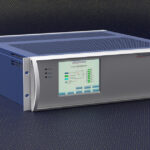By Karen Van Dyke, Director, Positioning, Navigation, and Timing (PNT) and Spectrum Management in the U.S. Department of Transportation Office of the Assistant Secretary for Research and Technology (OST-R)
Bio: Karen Van Dyke serves as the Director for Positioning, Navigation, and Timing (PNT) and Spectrum Management in the U.S. Department of Transportation Office of the Assistant Secretary for Research and Technology (OST-R). Karen has been involved in navigation-related programs for over 30 years starting at the Volpe National Transportation Systems Center in Cambridge, Mass, before transitioning to her current role at DOT Headquarters in Washington, D.C., where she is responsible for overseeing the navigation program and development of policy positions on PNT and radiofrequency spectrum in coordination with DOT leadership within the Office of the Secretary of Transportation.
Safety is the U.S. Department of Transportation’s top priority. PNT services must be accurate, reliable, available, and trustworthy to safely and effectively support current and emerging transportation services, applications, and supporting infrastructures.
The transportation sector is one of the largest users of civil PNT services. Aviation systems rely significantly upon the consistency and integrity of PNT signals throughout all phases of a flight—from preflight and takeoff to approach and landing. The rail industry relies on PNT for its shared track and Positive Train Control (PTC) systems. PNT is crucial in the maritime industry and is used by mapping systems to avoid grounding, beacon systems to track ships and avoid accidents, and sensors for clearance under bridges.
PNT also plays a critical role in the ever-evolving cooperative and automated technologies and systems as they are more broadly implemented and integrated into today’s transportation environments. A prime example is connected and automated vehicles, not only cars, trucks, and buses but also bicycles, motorcycles, wheelchairs, drones, and other forms of mobility that need to integrate safely and effectively onto our roadways and into our air space with human drivers and pilots. As technology evolves, each of these systems are becoming Highly Automated Transportation Systems (HATS).
PNT services are key enablers to our Nation’s critical infrastructure, providing technologies and operations used in synchronization of telecommunications, mobile Internet of Things (IoT), power generation and transmission, financial transactions, precision agriculture, surveying, advanced construction technologies, mining and exploration for natural resources, earthquake detection, space missions, scientific applications, and other important civil uses.
Per Space Policy Directive 7, DOT co-chairs the National Space-Based PNT Executive Committee (EXCOM), which is the interagency body for guiding whole-of government interests in the provision of space-based PNT services and augmentations, as well as PNT resiliency. In this role, DOT represents the civil departments and agencies in GPS development, acquisition, management, and operations. DOT also participates in radionavigation planning and requirements development activities, including development of the Federal Radionavigation Plan (FRP) in partnership with the DOD and Department of Homeland Security (DHS) to reflect the policy, planning and requirements development activities for federally provided PNT systems.
DOT also is committed to investing in Science, Technology, Engineering, and Mathematics (STEM) education and developing the U.S. PNT workforce of the future. DOT currently is working with two University Transportation Centers (UTCs) whose research is focused on Assured PNT:
• The Center for Assured and Resilient Navigation in Advanced TransportatION Systems (CARNATIONS) led by the Illinois Institute of Technology (IIT)
• The Center for Automated Vehicles Research with Multimodal AssurEd Navigation (CARMEN+) led by The Ohio State University, whose work is featured in this section.
The Imperative of Protect, Toughen, Augment and Adopt (PTAA)
GPS relies on a low power signal from space and is subject to cyberattacks, jamming, spoofing, denial of service, and other malicious actions. GPS is also susceptible to natural interference events, e.g., space weather. Degraded, denied, and/or manipulated PNT, or PNT that is used improperly, can lead to disastrous and sometimes fatal consequences.
As the lead Federal department for Civil PNT, DOT must address both current and future challenges that include:
• Increasing occurrences of GPS jamming and spoofing and the ability to quickly detect and mitigate interference.
• Fostering implementation of PNT cybersecurity awareness and protections as new forms of cyberattacks continue to emerge.
• Promoting “responsible use” and “risk-based decision-making” by PNT users, especially for critical infrastructure operations.
• The need to toughen GPS user equipment against intentional jamming as well as signal and data spoofing.
• Increasing dependency on precision timing.
Given the growing reliance on PNT within civil applications, it is imperative that civil PNT users have uninterrupted PNT services. This imperative is reflected in the policy of the U.S. Government’s Executive Order 13905, Strengthening National Resilience Through Responsible Use of PNT Services, that seeks “to ensure that disruption or manipulation of PNT services does not undermine the reliable and efficient functioning of its critical infrastructure…and [to] ensure critical infrastructure can withstand disruption or manipulation of PNT services.”
To address these challenges, DOT embraces the Protect, Toughen, and Augment (PTA) principles developed by the National Space-Based PNT Advisory Board. PTA is a critical set of principles, but they are not fully sufficient until they are put into use. Thus, adoption extends these important principles to Protect, Toughen, Augment and Adopt (PTAA).
PTAA initiatives focus on establishing greater resiliency, resulting in PNT services remaining consistent and available in the event of human-made or natural disruptions, including:
• Protecting spectrum that delivers PNT signals and creating a robust nationwide interference detection and location system that can be used to alert users, mitigate interference problems, and enable recovery following PNT degradation or failures.
• Cyber toughening PNT user equipment and working with partners from DOD and the State Department to address International Traffic in Arms Regulations (ITAR) and Export Administration Regulations (EAR) considerations for use of multi-element Controlled Reception Pattern Antennas (CRPA) for civil applications. Standards and specifications to design these capabilities into future systems must be created.
• Embracing a diversity of PNT sources that can provide accurate, reliable, and resilient PNT services by enhancing existing systems with new technologies that can serve a broad range of civil PNT needs and that have been assessed by the U.S. Government to understand their capabilities and vulnerabilities.
Need for Resilience and How CPNT Endeavors to Deliver It
Complementary PNT (CPNT) incorporates other sources of positioning, navigation, and/or timing to complement or augment space-based PNT systems (e.g., GPS, GNSS). CPNT services are defined by their source location (space-based or terrestrial), their service volume (local at a fixed point versus regional or global), and their autonomy (dependent, requiring frequent refresh rates versus autonomous with no refresh needed once initialized).
DOT developed a Complementary PNT Action Plan to drive CPNT adoption across the Nation’s transportation system and within other critical infrastructure sectors. The DOT Complementary PNT Action Plan addresses disruption, denial and manipulation of GPS. These GNSS vulnerabilities include unintentional and intentional jamming and spoofing (both measurement and data spoofing) of the GPS signal and physically impeded environments in which the availability of the GPS signal is impacted (e.g., indoors, underground, and urban canyons). This plan is intended to address GPS vulnerabilities/limitations on both a widespread and local scale.
The DOT CPNT Action Plan, issued on Sept, 11, 2023, has five components:
1. Developing safety-critical PNT standards for transportation services.
2. Developing a PNT vulnerability and performance testing framework on demonstrated and suitable complementary technologies.
3. Conducting vulnerability performance assessments at test ranges and proving grounds (sandbox facilities).
4. Developing PNT performance monitoring capabilities to ensure PNT services provide operational resilience and achieve safety critical standards.
5. Establishing a Federal PNT Services Clearinghouse.
As part of the Rapid Phase of the CPNT Action Plan, DOT recently awarded contracts to nine CPNT technology vendors. These awards will enable DOT to conduct real-world field tests of commercial PNT technologies to facilitate adoption into systems that depend on secure and reliable PNT services.
Awarded through the Volpe Center, in response to the Rapid Phase of the DOT Complementary PNT Action Plan, and totaling more than $7.2 million, these awards provide funding for instrumentation, testing and evaluation of CPNT technologies at field test ranges in conjunction with critical infrastructure owners and operators. The goal is to facilitate adoption of CPNT technologies to improve PNT resiliency.
The CPNT technologies covering low Earth orbit (LEO), Terrestrial RF, Time Over Fiber, and Map Matching/Map Tracking will be fielded within six months after award at a diverse set of test range models (Federal Government-Hosted, Critical Infrastructure and Vendor-Fielded).
Adoption and use of appropriate CPNT services by critical infrastructure owners, operators and users will ensure the Nation’s critical infrastructure has continuous and reliable PNT services.






